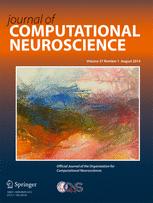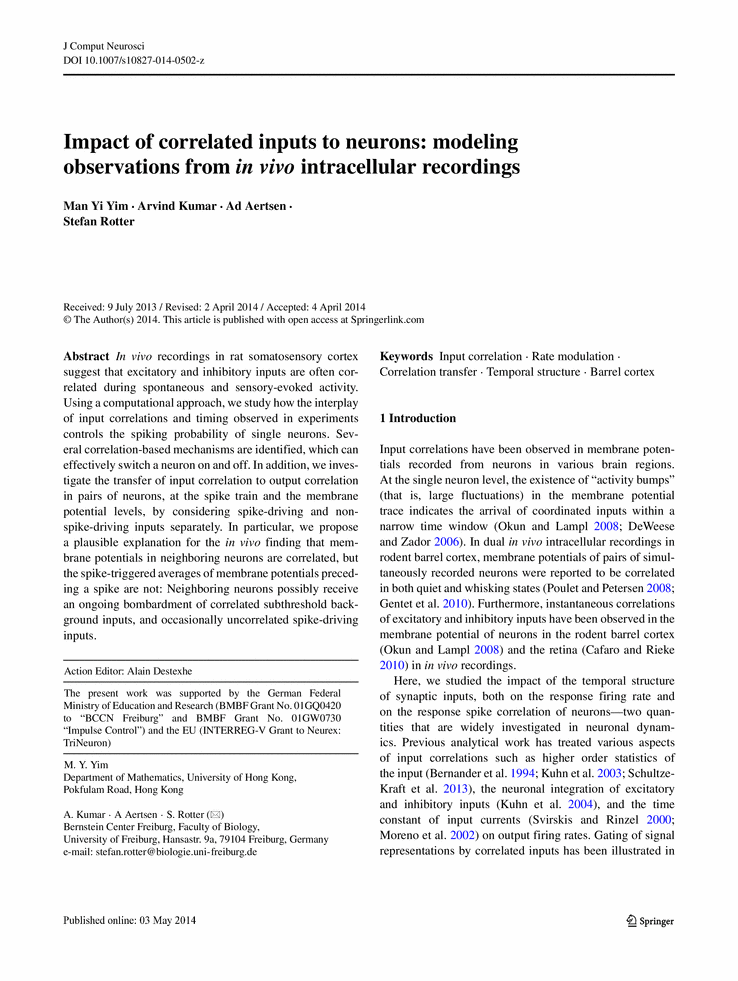Impact of correlated inputs to neurons: modeling observations from in vivo intracellular recordings
- Man Yi Yim,
- Arvind Kumar,
- Ad Aertsen,
- Stefan Rotter
- … show all 4 hide
Abstract
In vivo recordings in rat somatosensory cortex suggest that excitatory and inhibitory inputs are often correlated during spontaneous and sensory-evoked activity. Using a computational approach, we study how the interplay of input correlations and timing observed in experiments controls the spiking probability of single neurons. Several correlation-based mechanisms are identified, which can effectively switch a neuron on and off. In addition, we investigate the transfer of input correlation to output correlation in pairs of neurons, at the spike train and the membrane potential levels, by considering spike-driving and non-spike-driving inputs separately. In particular, we propose a plausible explanation for the in vivo finding that membrane potentials in neighboring neurons are correlated, but the spike-triggered averages of membrane potentials preceding a spike are not: Neighboring neurons possibly receive an ongoing bombardment of correlated subthreshold background inputs, and occasionally uncorrelated spike-driving inputs.
- Atallah, B.V., & Scanziani, M. (2009). Instantaneous modulation of gamma oscillation frequency by balancing excitation with inhibition. Neuron, 62(4), 566–577. CrossRef
- Bernander, O., Koch, C., Usher, M. (1994). The effect of synchronized inputs at the single neuron level. Neural Computation, 6(4), 622–641. CrossRef
- Binzegger, T., Douglas, R.J., Martin, K.A.C. (2004). A quantitative map of the circuit of cat primary visual cortex. Journal of Neuroscience, 24(39), 8441–8453. CrossRef
- Boucsein, C., Nawrot, M.P., Schnepel, P., Aertsen, A. (2011). Beyond the cortical column: abundance and physiology of horizontal connections imply a strong role for inputs from the surround. Frontiers in Neuroscience, 5, 32. CrossRef
- Braitenberg, V., & Schüz, A. (1991). Anatomy of the cortex: statistics and geometry. Berlin: Springer.
- Bruno, R.M., & Sakmann, B. (2006). Cortex is driven by weak but synchronously active thalamocortical synapses. Science, 312(5780), 1622–1627. CrossRef
- Cafaro, J., & Rieke, F. (2010). Noise correlations improve response fidelity and stimulus encoding. Nature, 468(7326), 964–967. CrossRef
- de la Rocha, J., Doiron, B., Shea-Brown, E., Josić, K., Reyes, A. (2007). Correlation between neural spike trains increases with firing rate. Nature, 448(7155), 802–806. CrossRef
- DeWeese, M.R., & Zador, A.M. (2006). Non-Gaussian membrane potential dynamics imply sparse, synchronous activity in auditory cortex. Journal of Neuroscience, 26(47), 12206–12218. CrossRef
- Diesmann, M., Gewaltig, M.O., Aertsen, A. (1999). Stable propagation of synchronous spiking in cortical neural networks. Nature, 402(6761), 529–533. CrossRef
- Ecker, A.S., Berens, P., Keliris, G.A., Bethge, M., Logothetis, N.K., Tolias, A.S. (2010). Decorrelated neuronal firing in cortical microcircuits. Science, 327(5965), 584–587. CrossRef
- Feng, J., & Brown, D. (2000). Impact of correlated inputs on the output of the integrate- and-fire model. Neural Computation, 12(3), 671–692. CrossRef
- Gentet, L.J., Avermann, M., Matyas, F., Staiger, J.F., Petersen, C.C.H. (2010). Membrane potential dynamics of GABAergic neurons in the barrel cortex of behaving mice. Neuron, 65(3), 422–435. CrossRef
- Gewaltig, M.-O., & Diesmann, M. (2007). NEST (NEural Simulation Tool). Scholarpedia, 2(4), 1430. CrossRef
- Koch, C. (1999). Biophysics of computation: information processing in single neurons. New York: Oxford University Press.
- Kremkow, J., Aertsen, A., Kumar, A. (2010). Gating of signal propagation in spiking neural networks by balanced and correlated excitation and inhibition. Journal of Neuroscience, 30(47), 15760–15768. CrossRef
- Kriener, B., Tetzlaff, T., Aertsen, A., Diesmann, M., Rotter, S. (2008). Correlations and population dynamics in cortical networks. Neural Computation, 20(9), 2185–2226. CrossRef
- Krumin, M., & Shoham, S. (2009). Generation of spike trains with controlled auto- and cross-correlation functions. Neural Computation, 21(6), 1642–1664. CrossRef
- Kuhn, A., Aertsen, A., Rotter, S. (2003). Higher-order statistics of input ensembles and the response of simple model neurons. Neural Computation, 15(1), 67–101. CrossRef
- Kuhn, A., Aertsen, A., Rotter, S. (2004). Neuronal integration of synaptic input in the fluctuation-driven regime. Journal of Neuroscience, 24(10), 2345–2356. CrossRef
- Kumar, A., Rotter, S., Aertsen, A. (2008). Conditions for propagating synchronous spiking and asynchronous firing rates in a cortical network model. Journal of Neuroscience, 28(20), 5268–5280. CrossRef
- Kumar, A., Rotter, S., Aertsen, A. (2010). Spiking activity propagation in neuronal networks: reconciling different perspectives on neural coding. Nature Reviews Neuroscience, 11(9), 615–627. CrossRef
- Léger, J.-F., Stern, E.A., Aertsen, A., Heck, D. (2005). Synaptic integration in rat frontal cortex shaped by network activity. Journal of Neurophysiology, 93(1), 281–293.
- McCormick, D.A., Connors, B.W., Lighthall, J.W., Prince, D.A. (1985). Comparative electrophysiology of pyramidal and sparsely spiny stellate neurons of the neocortex. Journal of Neurophysiology, 54(4), 782–806.
- Moreno, R., de la Rocha, J., Renart, A., Parga, N (2002). Response of spiking neurons to correlated inputs. Physical Review Letters, 89(28 Pt 1), 288101. CrossRef
- Moreno-Bote, R., & Parga, N. (2006). Auto- and crosscorrelograms for the spike response of leaky integrate-and-fire neurons with slow synapses. Physical Review Letters, 96(2), 028101. CrossRef
- Okun, M., & Lampl, I. (2008). Instantaneous correlation of excitation and inhibition during ongoing and sensory-evoked activities. Nature Neuroscience, 11(5), 535–537. CrossRef
- Petreanu, L., Mao, T., Sternson, S.M., Svoboda, K. (2009). The subcellular organization of neocortical excitatory connections. Nature, 457(7233), 1142–1145. CrossRef
- Poulet, J.F.A., & Petersen, C.C.H. (2008). Internal brain state regulates membrane potential synchrony in barrel cortex of behaving mice. Nature, 454(7206), 881–885. CrossRef
- Renart, A., de la Rocha, J., Bartho, P., Hollender, L., Parga, N., Reyes, A., Harris, K.D. (2010). The asynchronous state in cortical circuits. Science, 327(5965), 587–590. CrossRef
- Rice, S.O. (1944). Mathematical analysis of random noise. Bell Systems Technical Journal, 23, 282–332. CrossRef
- Rosenbaum, R., & Josic, K.I. (2011). Mechanisms that modulate the transfer of spiking correlations. Neural Computation, 23(5), 1261–1305. CrossRef
- Rosenbaum, R.J., Trousdale, J., Josić, K. (2010). Pooling and correlated neural activity. Frontiers in Computational Neuroscience, 4, 9.
- Salinas, E., & Sejnowski, T.J. (2000). Impact of correlated synaptic input on output firing rate and variability in simple neuronal models. Journal of Neuroscience, 20(16), 6193–6209.
- Sceniak, M.P., & Sabo, S.L. (2010). Modulation of firing rate by background synaptic noise statistics in rat visual cortical neurons. Journal of Neurophysiology, 104(5), 2792–2805. CrossRef
- Schultze-Kraft, M., Diesmann, M., Grün, S., Helias, M. (2013). Noise suppression and surplus synchrony by coincidence detection. PLoS Computational Biology, 9(4), e1002904. CrossRef
- Shadlen, M.N., & Newsome, W.T. (1998). The variable discharge of cortical neurons: implications for connectivity, computation, and information coding. Journal of Neuroscience, 18(10), 3870–3896.
- Shea-Brown, E., Josić, K., de la Rocha, J., Doiron, B. (2008). Correlation and synchrony transfer in integrate-and-fire neurons: basic properties and consequences for coding. Physical Review Letters, 100(10), 108102. CrossRef
- Softky, W.R., & Koch, C. (1993). The highly irregular firing of cortical cells is inconsistent with temporal integration of random EPSPs. Journal of Neuroscience, 13(1), 334–350.
- Song, S., Sjöström, P.J., Reigl, M., Nelson, S., Chklovskii, D.B. (2005). Highly nonrandom features of synaptic connectivity in local cortical circuits. PLoS Biology, 3(3), e68. CrossRef
- Svirskis, G., & Rinzel, J. (2000). Influence of temporal correlation of synaptic input on the rate and variability of firing in neurons. Biophysical Journal, 79(2), 629–637. CrossRef
- Tchumatchenko, T., Malyshev, A., Geisel, T., Volgushev, M., Wolf, F. (2010). Correlations and synchrony in threshold neuron models. Physical Review Letters, 104(5), 058102. CrossRef
- Tiesinga, P., Fellous, J.-M., Sejnowski, T.J. (2008). Regulation of spike timing in visual cortical circuits. Nature Reviews Neuroscience, 9(2), 97–107. CrossRef
- Troyer, T. W., & Miller, K. D. (1997). Physiological gain leads to high ISI variability in a simple model of a cortical regular spiking cell. Neural Computation, 9(5), 971–983. CrossRef
- van Vreeswijk, C., & Sompolinsky, H. (1996). Chaos in neuronal networks with balanced excitatory and inhibitory activity. Science, 274(5293), 1724–1726. CrossRef
- Wilent, W.B., & Contreras, D. (2005). Dynamics of excitation and inhibition underlying stimulus selectivity in rat somatosensory cortex. Nature Neuroscience, 8(10), 1364–1370. CrossRef
- Yim, M.Y., Aertsen, A., Kumar, A. (2011). Significance of input correlations in striatal function. PLoS Computational Biology, 7(11), e1002254. CrossRef
- Zhou, Y., Liu, B.-H., Wu, G.K., Kim, Y.-J., Xiao, Z., Tao, H.W., Zhang, L.I. (2010). Preceding inhibition silences layer 6 neurons in auditory cortex. Neuron, 65(5), 706–717. CrossRef
- Title
- Impact of correlated inputs to neurons: modeling observations from in vivo intracellular recordings
- Open Access
- Available under Open Access This content is freely available online to anyone, anywhere at any time.
- Journal
-
Journal of Computational Neuroscience
- DOI
- 10.1007/s10827-014-0502-z
- Print ISSN
- 0929-5313
- Online ISSN
- 1573-6873
- Publisher
- Springer US
- Additional Links
- Topics
- Keywords
-
- Input correlation
- Rate modulation
- Correlation transfer
- Temporal structure
- Barrel cortex
- Industry Sectors
- Authors
-
- Man Yi Yim (1)
- Arvind Kumar (2)
- Ad Aertsen (2)
-
Stefan Rotter
 (2)
(2)
- Author Affiliations
-
- 1. Department of Mathematics, University of Hong Kong, Pokfulam Road, Hong Kong
- 2. Bernstein Center Freiburg, Faculty of Biology, University of Freiburg, Hansastr. 9a, 79104, Freiburg, Germany
-




